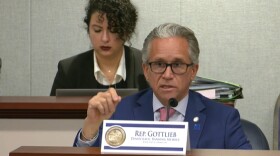Public lands in Lee and Collier counties managed by Florida and the South Florida Water Management District remain so dangerous more than two weeks after Hurricane Ian’s SWFL passage that they will remain closed for the foreseeable future.
Chauncey Goss, chairman of the water district, was in a helicopter Friday examining the drainage creeks and waterways that are designed to carry floodwaters from populated areas like downtown Fort Myers out to area bays and the Gulf of Mexico.
“We’ve been working on them for several years to make sure that they do open up,” Goss said, along with some help from clean-out crews. “We did avoid some flooding because of that.”
Floodwaters have backed up in some debris-filled canals and creeks, and the water management districts workers are clearing those like Ten Mile Canal, which is a 20-mile man-made stream the runs south from near downtown Fort Myers south to Estero Bay. Then workers will move to clear the Orange River and Daughtrey, Hickey, and Telegraph creeks.
Still, detritus on land and underwater are creating such a potential for injury and disease transmission that Goss said Friday it is best to keep the pubic away from the areas.
The water management agency’s emergency operations center remains at level one, which is full activation, even 15 days after Ian made landfall at Cayo Costa State Park.
Nearly all Florida State Parks, campgrounds and cabins facilities in Southwest Florida are closed due to often overwhelming damage from Category 4 Hurricane Ian. Openings will be announced on each park’s website.
Floridahikes.com advises outdoor enthusiasts to avoid any travel to the hardest hit outdoor areas in Everglades City, Marco Island, Naples, Estero, Fort Myers, Punta Gorda, Charlotte Harbor, Englewood, North Port, and Venice.
However, public lands managed by the South Florida district in Monroe, Orange, Osceola, Polk, Okeechobee, Highlands, Glades, Charlotte, Hendry, St. Lucie, Martin, Palm Beach, Broward, and Miami-Dade counties are open.
On the water
The Florida Fish and Wildlife Conservation Commission is warning boaters of the life-threatening potential of all the floating debris in canals, in the Intracoastal Waterway, and bobbing in larger water bodies like Charlotte Harbor, Pine island Sound, and along the Gulf of Mexico coastline off Lee and Collier counties.
“We have damaged and submerged navigation markers, displaced vessels and other debris in some waterways that might not be visible,” said Rob Beaton, the agency’s boating and waterways section leader. “Please use caution.”
Beaton said boaters should stay in port for now.
If there is a specific reason someone needs to be on the water, captains should go slow using extreme caution. A lookout, not the captain, should be in a secure spot on the boat with his “head on a swivel” looking for floating trees, construction debris, parts of buildings, vehicles, other boats, and all the other stuff Hurricane Ian whipped about.
And do not hang around hard-hit areas where emergency workers are handling a situation. Florida law requires captains – whoever is driving the boat is the captain; one doesn’t have to go through a course to earn the title – boating within 300 feet of any emergency vessel when the emergency lights are on to maintain a slow speed with minimum wake, which means the boat is traveling just a few miles per hour sending out a wake that looks more like ripples in the water.
Captains with excellent local knowledge, or familiarity, with certain waters should act like they have never been there before. Many aides to navigation or missing or submerged, shifting sands underwater have moved shoals and created new shallow areas. The splinted end of a broken piling may stick up just inches under the surface of the water.
Beaton also said that, even more important than normal, the captain and every person on board should wear a snapped closed or zipped life jacket at all times whether required to or not. Being thrown from a vessel and drowning is the number one cause of boating deaths – if the person has a life jacket on the chances of living rise dramatically.
Boater are encouraged to report missing or damaged waterway markers by calling 866-405-2869, or by filling out an online form at MyFWC.com/boating, by clicking “Waterway Management” then “Waterway Markers” and “Reporting Damaged/Missing Waterway Markers.”
In the water
The best bet right now is to stay out of the water.
Sewage pipelines overflowed into waterways. Toppled portable toilets spilled into floodwaters. Gasoline and motor oil leaked from partly submerged vehicles. Downed trees have started decomposing on waterlogged roads.
That’s from the Sarasota Bay National Estuary Program’s Dave Tomasko, who is the organization’s director. He saw all of that and more in the waters near North Port and other spots in Sarasota County when on the water recently to collect data to determine whether the water is safe for people to enter.
After his tour, Tomasko said people should stay out of the water for health reasons.
“What’s in the water is pretty gross,” Tomasko told The Washington Post, who first reported his findings. “Our bays look like root beer right now. It smells terrible.”
Since Ian’s landfall Sept. 28, Tomasko has received dozens of calls reporting overflows from wastewater treatment plants from Palmetto south to Fort Myers.
The Post reported that Hurricane Ian left scars in the water as well as on land:
The storm’s winds and excessive rain washed leaves, organic matter and contaminants into streams and the bays, signaling the beginning of serious environmental effects that could emerge. The degraded water quality could damage aquatic ecosystems for weeks, months or longer and pose a danger to human health in the short term.
Images and videos from space captured the extent of the runoff.
“The fact that you can see it from a satellite is pretty impressive to the magnitude of freshwater that’s coming off the landscape,” Todd Osborne, a biogeochemist at the University of Florida, told the Post. “That’s all that excessive rain flushing that material out into the near-shore waters … and the storm surge inundating the landscape, turning up lots of sediment and then flowing back into the ocean.”
The Florida Medical Examiners Commission said late Friday that there are now 109 deaths attributed to Hurricane Ian. Fifty-four people died in Lee County and seven each in Sarasota, Charlotte, and Monroe counties. Five people died in Collier County, two in Hendry County, and one in DeSoto County.
Environmental reporting for WGCU is funded in part by VoLo Foundation, a non-profit with a mission to accelerate change and global impact by supporting science-based climate solutions, enhancing education, and improving health.
Sign up for WGCU's monthly environmental newsletter, the Green Flash, today.
WGCU is your trusted source for news and information in Southwest Florida. We are a nonprofit public service, and your support is more critical than ever. Keep public media strong and donate now. Thank you.








